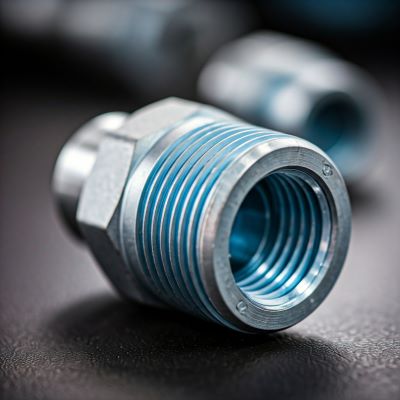In the world of engineering and manufacturing, precision is paramount. Thread standards play a crucial role in ensuring the compatibility and reliability of components. Among these standards, the UNS (Unified National Special) thread stands out for its versatility and specialized applications.
This guide will provide a comprehensive overview of the UNS thread standard, making it easy to understand and apply in your projects.
Why Understanding the UNS Thread Standard Matters
Understanding the UNS thread standard is essential for several reasons:
➡️ Ensuring Compatibility: UNS threads are designed for specific applications, ensuring compatibility with other components and systems.
➡️ Improving Precision: The precise dimensions and tolerances of UNS threads contribute to improved accuracy and performance in various assemblies.
➡️ Facilitating Manufacturing: The standardized nature of UNS threads simplifies manufacturing processes, leading to increased efficiency and cost-effectiveness.
What Is the UNS Thread Standard?
The UNS thread standard falls under the broader umbrella of the Unified National Thread System (UNTS). It represents a series of thread forms with specific pitch diameters, designed to address unique engineering requirements.
➡️ Defining the UNS Thread Standard: UNS threads are characterized by their non-standard pitch. Unlike common UNC (Unified National Coarse) or UNF (Unified National Fine) threads, UNS threads have a unique number of threads per inch, tailored to specific applications.
➡️ The Purpose and History of the UNS Classification System: The UNS classification system was developed to accommodate specialized engineering needs that could not be met by standard thread series. It provides flexibility in designing and manufacturing components for various industries.
➡️ How UNS Threads Differ from Other Thread Standards: The primary distinction of UNS threads lies in their non-standard pitch. This unique characteristic allows for optimized performance in applications requiring specific thread engagement, load-bearing capacity, or clearance.
Key Features of the UNS Thread Standard
➡️ Thread Dimensions and Specifications: UNS threads are defined by their major diameter, pitch diameter, and number of threads per inch. These dimensions are carefully specified to meet the demands of the intended application.
➡️ Strength and Durability: UNS threads are designed to withstand significant loads and stresses, making them suitable for critical applications in various industries.
➡️ Flexibility in Custom Applications: The ability to customize the thread pitch provides engineers with greater flexibility in designing components for specific requirements.
Benefits of Using UNS Thread Standard
Here are the benefits of UNS thread:
➡️ Enhanced Compatibility with Various Materials: UNS threads can be used with a wide range of materials, including metals, plastics, and composites.
➡️ Improved Precision for Industrial and Engineering Projects: The precise dimensions and tolerances of UNS threads contribute to improved accuracy and reliability in critical applications.
➡️ Cost-Effectiveness in Manufacturing Processes: The standardized nature of UNS threads simplifies manufacturing processes, leading to reduced costs and increased efficiency.
How to Identify and Measure UNS Threads
➡️ Tools Needed for Accurate Thread Measurement:
➡ Thread gauges
➡ Micrometers
➡ Telescoping gauges
➡ Calipers
➡️ Step-by-Step Guide to Identifying UNS Threads:
➡ Visual Inspection: Examine the thread profile for any unique characteristics.
➡ Measure the Major Diameter: Use a micrometer to measure the largest diameter of the thread.
➡ Determine the Thread Pitch: Use a thread gauge or count the number of threads per inch.
➡ Consult Reference Materials: Refer to the UNS thread standard tables to compare your measurements and identify the specific thread type.
➡️ Common Mistakes to Avoid When Measuring Threads:
➡ Inaccurate measurements
➡ Incorrect use of measuring tools
➡ Misinterpretation of thread characteristics
Applications of the UNS Thread Standard
➡️ Industries that Rely on UNS Threads:
➡ Aerospace
➡ Automotive
➡ Defense
➡ Marine
➡ Oil and Gas
➡ Medical
➡️ Examples of UNS Thread Usage in Everyday Products:
➡ Aircraft components
➡ Automotive engines
➡ Medical implants
➡ Industrial machinery
➡️ Why UNS Threads are Preferred in Critical Applications: UNS threads are often preferred in critical applications due to their high strength, precision, and reliability.
Choosing the Right UNS Thread for Your Project
➡️ Factors to Consider When Selecting UNS Threads:
➡ Application requirements
➡ Load-bearing capacity
➡ Material compatibility
➡ Clearance requirements
➡️ Comparing UNS Threads with Other Thread Types: Compare the advantages and limitations of UNS threads with other thread standards, such as UNC, UNF, and metric threads, to make an informed decision.
➡️ Tips for Ensuring Optimal Thread Performance:
➡ Use appropriate lubricants and assembly techniques
➡ Maintain proper torque during assembly
➡ Regularly inspect and maintain threaded components
Challenges and Solutions in Using UNS Threads
➡️ Potential Issues with Thread Compatibility: Ensure compatibility with other components by carefully selecting the appropriate UNS thread for your application.
➡️ Addressing Wear and Tear in UNS Threads: Regular inspection and maintenance can help prevent wear and tear and ensure the long-term performance of UNS threads.
➡️ Maintenance Tips for Long-Lasting Thread Performance:
➡ Keep threads clean and free from debris
➡ Use appropriate lubricants
➡ Avoid over-tightening
Conclusion
The UNS thread standard plays a vital role in modern engineering and manufacturing. By understanding its characteristics, benefits, and applications, you can effectively utilize UNS threads to enhance the performance and reliability of your projects. Embracing the UNS thread standard can lead to significant improvements in efficiency, precision, and overall success in various industries.
Post time: Jan-13-2025


